
Atlas F1 Technical Writer
As the season progresses to Barcelona, the hub for much of the teams testing programmes, the Spanish Grand Prix typically sees the teams as prepared as they can be for racing and little in the way of change. Atlas F1's Craig Scarborough analyses the changes seen last weekend and reviews the cars' performance
The circuit was revised over the winter with a new first corner and tightened complex in Sector 2, but these changes were well in advance of the testing here, so every team had experience of the layout. But with all the testing that occurs here, the teams still need to dial their cars into the track. Which is tricky due to the changes in temperature, wind and track surface over the course of the weekend, as well as each of these factors starting from a very different baseline compared to winter testing.
With long fast corners with an abrasive track surface which degrades tyres quickly, most of the teams work over the Friday session was evaluating the tyre choices and not quite so much as usual on set up.
Rear wings
BAR's original fences attached to the main plane of the rear wing and formed a three-sided shark tooth profile (Image #2); this went against the FIA definition of an aerofoil profile. At Imola BAR reshaped the fences to make a two-sided profile, while Williams dropped their fences.
Jaguar arrived in Spain with what initially looked to be a rectangular fence, which by its definition makes a four sided profile and hence illegal. But in a loophole in the rules, Jaguar have actually created pairs of two overlapping fences; one attached to the main plane and one to the rear flap. Each individually forms a two sided profile, but when placed immediately next to each other they make up the rectangular shape. No protests were lodged against the design, but should another team adopt them, then a further clarification may be forthcoming from the FIA.
Team by Team
Ferrari
Yet again no major technical alterations to the F2004's were seen in Spain. To allow for longer wheel travel over the kerbs, Barrichello's car ran with extended rear torsion bars, visibly protruding through the rear bodywork.
On Friday the team topped the times in the first session while the track was dirty and dropped their pace relative to rest of the field in the second session. Tyre choice was decided, and proved subsequently to be split between the softer compound for Schumacher and a harder one for Barrichello, with a weekend strategy to send Barrichello out on a different fuel strategy to the rest of the field.
This was necessary as Barrichello has been struggling to pass from his lower grid placings in recent races, and simply following his rivals on the same pit strategy doesn't allow him to make up places. By opting for a different strategy he would be out of sync with his rivals and able to lap in clean air, thus extracting the potential from the car.
The cost of this strategy was Barrichello running on heavy fuel tanks and running as many laps possible in his opening stint, but aiding this strategy was a Shell fuel designed to be volumetrically efficient rather than the more usual gravimetrically efficient fuel. Volumetrically efficient fuel is lighter at the cost of horsepower potential, while gravimetric efficiency provides the maximum power at the expense of weight. In Spain weight costs dearly in terms of lap times, so a lighter but full-up fuel tank makes a good compromise.
Saturday saw the drivers conserving engine mileage in the free practice sessions, most of them not running for over thirty minutes in the first session. Schumacher ran first in Qualifying 1, costing him time as the track speeded up over the session, but a clean pair of opening sectors in his Qualifying 2 lap gave him space to ease off in Sector 3. Barrichello ran only slightly later in Qualifying 1, but in Qualifying 2 he was running with heavy tanks and harder tyres so his clean lap was fast for his set up.
In the race adequate starts saw the drivers retain reasonable positions, with Barrichello on heavy fuel stopping 7 laps later than Schumacher lap 10 stop.
Ferrari are unique in Formula One in having so many detailed panels along the inside of the sidepods; these aid the aerodynamics, and it seems also to provide a convenient amount of heat shielding. By managing his revs the exhaust held together for another 1-2 finish, proving Barrichello's strategy gamble was a wise one.
Renault
Mentioned but not detailed in the Imola technical review was the slot added to the rear wing endplate; this simple adaptation works much like Minardi's solution, allowing flow to pass from inside the endplate to the outside, negating the losses from the longer endplate mandated for 2004. The rear end of the Renault is by far the most complex in the pit lane; this change, along with the remotely mounted rear flap, acts to evacuate flow from within the wing, making the trailing wake and vortex structures broader apart for the improvement in drag. .
Trulli made the perfect race start, leading to wild rumours of covert launch control. More realistically the Renault has an efficient clutch release mechanism, both at the paddle on the steering wheel and the mechanism at the gearbox end. It transpires that, although launch control has been banned, some of the lessons learnt from implementing it can still be applied to a passive system; Renault pioneered the use of the clutch as part of the launch/traction control strategy, and they have simply transferred this knowledge better than the opposition. The balance of the race ran trouble free leading to a competitive 3-4 finish.
BAR
With much expectation loaded onto the team after recent race performances, BAR arrived in Barcelona with some revised bargeboards and a small engine step to the Imola spec engine.
As has become the norm BAR starred in Friday practice, with third driver Anthony Davidson able to run more laps than the two racing drivers without fear of overusing his engine. Meanwhile Takuma Sato suffered clutch problems, limiting his running to just a handful of laps.
With the lack of Sato's track time, and always changeable wind direction, BAR never found a perfect set up and struggled a little for grip. Despite this they bounced back with a fast lap for Sato, while an error wrecked Jenson Button's lap.
The race start saw Sato almost beat Schumacher to the first corner, but he subsequently dropped back struggling for grip from his Michelins. Equally Button unexpectedly found himself down the grid, without the option to change his strategy to react to it, struggled in traffic and never really made an impact on the race. Despite his fast straight-line speed he couldn't get close enough through the last corner to overtake on the straight.
Williams
After testing in the UK, Williams arrived in Spain with a revised BMW engine now proven to run to the same revs in the race as in qualifying. This is part of BMW strategy to improve the engines performance in the later part of its 800km life.
Aerodynamic development saw the shelf wing, debuted on Friday at Imola, raced for the first time, as well as revised rear wing fences. Unlike Ferrari, the Williams drivers only put in fast lap times towards the end of the Friday sessions, albeit someway down the time sheets.
After several races with heavier fuel loads for Qualifying 1 and Qualifying 2 the team opted to run light for Qualifying 1 to gain an advantage on the grippier track; this worked and Juan Pablo Montoya's Qualifying 2 run put him on the front row.
In the race neither driver made a great start, with Montoya being overtaken by the BAR and Renault, then soon after Montoya ran into brake problems; the team had chosen to go marginal on brake cooling in return for less aerodynamic drag. The lack of cooling to the brakes soon saw them overheating, leading to a long pedal; while this hindered Montoya's lap times, the real damage was the effect of running carbon brakes hot, which leads to accelerated wear to the point of brake disc failure. At Montoya's final pit stop his brakes faded to the point where he rammed his front jack man as he struggled to slow the car; the rear brakes were also smoking alarmingly and he was forced to retire.
Meanwhile Ralf Schumacher, who ran a lonelier race, was able to preserve his brakes, and despite a few off track excursions into the slower complexes was able to finish the race.
McLaren
With development pointed at the new car already delayed until the German GP no major improvements were seen on the McLaren. However, with the pit lane awash with photographers it has been possible to spot the asymmetric layout of their cooling system. McLaren run small open ducts in the shoulders of the sidepods; these are hard to spot and compare. This view shows how the left duct is larger to cope with the additional oil cooling in that sidepod.
Qualifying saw laps slower than their true potential, putting them all the way down in tenth and thirteenth. In the race their pace was still below expectations, and trouble in the pits cost more time, from David Coulthard overshooting his pit and having fuel rig problems, while Raikkonen made both adjustments to the car and required some pressure added to the engines pneumatic system. The latter issue proving Mercedes are still not over their reliability problems.
Jaguar
Jaguar appeared in Barcelona with the previously described rear wing fences. These were tried secretly in straight-line testing at Ford's Lommel facility in Belgium; this test also included some (passive) launch control testing.
Both drivers got dreadful starts, losing several places as they were almost left behind. A litany of problems saw Webber lose time with a wheel change and lack of grip, while Klien ran off the circuit and later retired with a throttle problem.
Sauber
With several detail aerodynamic components on the car for Spain Sauber were expecting a better performance than transpired. Friday saw the drivers struggling for grip, especially on shorter runs, which proved bad for qualifying if a little better for the race. Qualifying 2 saw Giancarlo Fisichella complete an error free, if slow, lap, while Felipe Massa went off track and lost time, finishing five places behind his teammate.
In the race poor starting Jaguars and durable Bridgestones saw an improved performance from both cars, Massa only being delayed with a self-inflicted flat spotted tyre.
Toyota
Encouraging pace was seen on Friday, particularly with Ricardo Zonta doing tyre comparisons in the third car. Qualifying went along a similar path, with Olivier Panis posting an excellent seventh. But the race saw a decline, with Panis struggling for grip on the Michelins followed by a drive through penalty for speeding in the pit lane and finally a hydraulic failure. Cristiano da Matta suffered a similar lack of grip but was able to run to the finish.
Jordan
Friday went cleanly for all three cars, and qualifying saw a bad lap from Nick Heidfeld still beating some other midfield cars. Giorgio Pantano made an error on his lap, but his pace was still good enough to keep him from being last on the grid. With this success the team's race soon turned sour; bad starts from both cars delayed them at the start, and hydraulic problems afflicted the cars, eventually retiring them both.ick Heidfeld, and hydraulic problems disabling the power steering on Giorgio Pantano's car saw a rare double retirement for any team in 2004.
Minardi
Minardi are still working through the set up required to get the most from the new sidepods. Friday and Saturday went by without technical drama and with Gianmaria Bruni putting in the better lap times. With Zsolt Baumgartner being left on the grid briefly at the start Minardi were down on pace compared to everyone; brake problems lead to Bruni spinning into retirement, while running off line under blue flags saw Baumgartner also spin off the track into retirement.
As the major testing venue for the closed season, and a popular choice during the early part of the open season, Barcelona is a circuit that all the teams enjoy and spend time at. This year's race weekend saw few innovations technically, with only Jaguar adopting something that raised a few eyebrows.
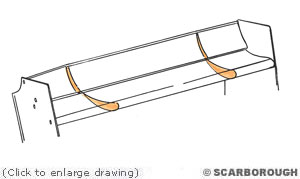 With the change in rear wing regulations over the winter and the start of the European mid season, the pace of teams developing and/or copying other teams' developments has picked up. Imola saw the result of a Jaguar protest and subsequent clarification of the rear wing fences adopted by BAR and latterly Williams. The FIA clarified what they believe constitutes a rear wing element, being two curves forming an aerofoil profile (Image #1).
With the change in rear wing regulations over the winter and the start of the European mid season, the pace of teams developing and/or copying other teams' developments has picked up. Imola saw the result of a Jaguar protest and subsequent clarification of the rear wing fences adopted by BAR and latterly Williams. The FIA clarified what they believe constitutes a rear wing element, being two curves forming an aerofoil profile (Image #1).
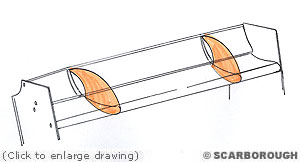 This imaginative interpretation of the rules is not new to Formula One; Ferrari ran two rear wings overlapped to span the total width of the car at Long beach in the eighties, Toleman used two rear wings in their TG183 of 1983, and Audi have run two sets of endplates on their sports cars in recent years.
This imaginative interpretation of the rules is not new to Formula One; Ferrari ran two rear wings overlapped to span the total width of the car at Long beach in the eighties, Toleman used two rear wings in their TG183 of 1983, and Audi have run two sets of endplates on their sports cars in recent years.
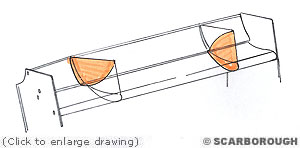 Despite this Rubens Barrichello still seems less at ease with the car than Michael Schumacher. It has been suggested that Barrichello's more flowing driving style suits a car with more understeer and rear end stability on corner entry; this is the inverse to Schumacher's style, as he prefers a car to be more nimble going into the apex of corners. The F2004 seems to have reversed the handling of the long wheelbase F2003GA which was less suited to Schumacher.
Despite this Rubens Barrichello still seems less at ease with the car than Michael Schumacher. It has been suggested that Barrichello's more flowing driving style suits a car with more understeer and rear end stability on corner entry; this is the inverse to Schumacher's style, as he prefers a car to be more nimble going into the apex of corners. The F2004 seems to have reversed the handling of the long wheelbase F2003GA which was less suited to Schumacher.
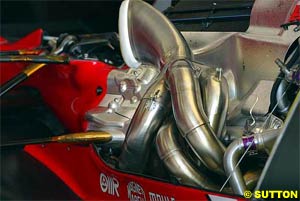 It was at this stage Schumacher suffered from a cracked exhaust; if bad enough this failure can lead to misfires and power loss, but usually the damage is more from the heat directed at the surrounding parts on the car. A similar problem cost Schumacher dearly in Monaco a few years ago when his rear suspension failed from the heat. Fortunately the crack wasn't too bad, and the Ferrari's internal streamlining and heat shielding protected the engine, cabling and suspension from the heat.
It was at this stage Schumacher suffered from a cracked exhaust; if bad enough this failure can lead to misfires and power loss, but usually the damage is more from the heat directed at the surrounding parts on the car. A similar problem cost Schumacher dearly in Monaco a few years ago when his rear suspension failed from the heat. Fortunately the crack wasn't too bad, and the Ferrari's internal streamlining and heat shielding protected the engine, cabling and suspension from the heat.
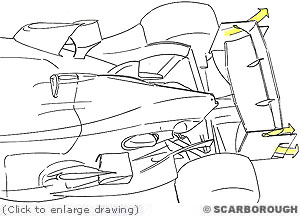 Mechanically the Imola B-spec engine was retained with the use of more revs for qualifying and the race. However the promise of the package is being thwarted by the team finding an inconsistent balance with the set up, particularly with nervousness from the rear end going into corners. Despite these issues there was still positive news from Friday's times, and by qualifying Jarno Trulli had found a better set up, while Fernando Alonso's lap was affected by the windy conditions.
Mechanically the Imola B-spec engine was retained with the use of more revs for qualifying and the race. However the promise of the package is being thwarted by the team finding an inconsistent balance with the set up, particularly with nervousness from the rear end going into corners. Despite these issues there was still positive news from Friday's times, and by qualifying Jarno Trulli had found a better set up, while Fernando Alonso's lap was affected by the windy conditions.
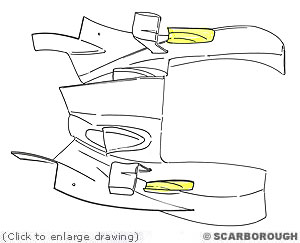 Friday started with a bad omen for Kimi Raikkonen when his car stopped on the tracked with an ignition coil failure, but the rules allow these sorts of parts to changed with the FIA's authority. Meanwhile neither driver was happy with the balance of the cars, but work was completed in selecting the tyre choice for the race.
Friday started with a bad omen for Kimi Raikkonen when his car stopped on the tracked with an ignition coil failure, but the rules allow these sorts of parts to changed with the FIA's authority. Meanwhile neither driver was happy with the balance of the cars, but work was completed in selecting the tyre choice for the race.
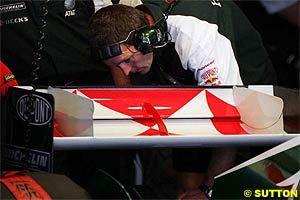 Work on their usual Friday programme was delayed when Christian Klien spun at the start of the faster second session, losing himself an hour of track time. Meanwhile Mark Webber and third driver Bjorn Wirdheim were relatively low on the time sheets. Improvements made by Webber on Saturday morning improved his pace, allowing him to qualify in the top ten, while Klien's lack of circuit time put him seven places behind his teammate.
Work on their usual Friday programme was delayed when Christian Klien spun at the start of the faster second session, losing himself an hour of track time. Meanwhile Mark Webber and third driver Bjorn Wirdheim were relatively low on the time sheets. Improvements made by Webber on Saturday morning improved his pace, allowing him to qualify in the top ten, while Klien's lack of circuit time put him seven places behind his teammate.
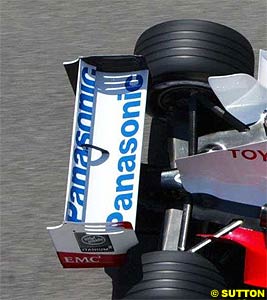 Some aero updates were brought to Spain, with the only visible change being three slots in the rear wing endplate over the previous two. Major revisions to the car are scheduled to debut at Silverstone.
Some aero updates were brought to Spain, with the only visible change being three slots in the rear wing endplate over the previous two. Major revisions to the car are scheduled to debut at Silverstone.
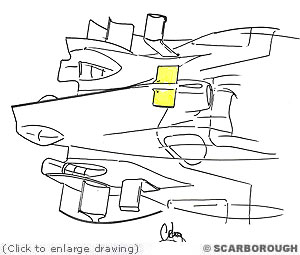 Having been one of the few teams to have run a mid wing regularly in previous years, Jordan produced one for the EJ14 in Spain. Using a narrower span than Ferrari and BAR, it was attached to the engine cover and, allied to other less visible aero changes, provided a boost to the team's pace.
Having been one of the few teams to have run a mid wing regularly in previous years, Jordan produced one for the EJ14 in Spain. Using a narrower span than Ferrari and BAR, it was attached to the engine cover and, allied to other less visible aero changes, provided a boost to the team's pace.
|
Contact the Author Contact the Editor |
Please Contact Us for permission to republish this or any other material from Atlas F1.
|
Volume 10, Issue 19
Atlas F1 Exclusive
Exclusive Interview with Mike Gascoyne
Bjorn Wirdheim: Going Places
Ann Bradshaw: Point of View
2004 Spanish GP Review
2004 Spanish GP Review
Technical Review: Spain 2004
Full House
Stats Center
Qualifying Differentials
SuperStats
Charts Center
Columns
The F1 Insider
Season Strokes
Elsewhere in Racing
The Weekly Grapevine
> Homepage |